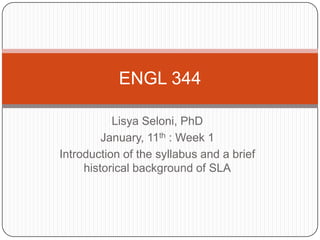
English 344 session 1
- 1. Lisya Seloni, PhD January, 11th : Week 1 Introduction of the syllabus and a brief historical background of SLA ENGL 344
- 2. Agenda Welcome and Introductions Class Activity: Find someone who Course Introduction Course Blog Course Materials and Assignments Brief historical Overview of SLA
- 3. Course Objectives The main objectives of this course are as follows: Explore fundamental concepts related to foreign and second language learning. Learn interdisciplinary approaches to teaching and learning a second language in diverse educational settings. Learn how a second language is acquired from linguistic, socio-cognitive, and sociocultural approach. Demystify stereotypes and mainstream understandings concerning second language learning and English language learners. Examine dialogic approaches to TESOL (e.g. issues related to language, culture, socio-economic status and identity).
- 4. Course Materials 1. Saville-Troike, M. (2006). Introducing Second Language Acquisition. 2. Wong, S. (2006). Dialogic Approaches to TESOL: Where the Ginko Tree Grows. 3. Lightbown, P. & Spada, N. (200). How languages are learned. Oxford Handbook for teachers. 4. Course blog and individual blog Foundationsoftesol.blogspot.com
- 5. Course Tasks and Assignments Refer to the syllabus.
- 6. What is SLA? Gass and Selinker define SLA as the study of how learners create a new language system (p.1) SLA has emerged from a field of study primarily from within linguistics (and subfield such as sociolinguistics, applied linguistics) and psychology. SLA is a research field that focuses on learners and learning rather than teachers and teaching. Questions we seek answers: What exactly does the L2 learner come to know? How does the learner acquire this knowledge? Why are some learners more successful than others?
- 7. Brief Historical Sketch of the field 60s and 70s: Behaviorist account of learning. What do learners bring the act of acquisition? How do learners transfer from L1? 70s: Acquisition orders (e.g. morpheme studies). Error analysis. This period was marked by research on non-classroom learners. Inapplicable to classroom learning. 80s: Krashen’s ideas on acquisition (Monitor theory. Acquisition vs. learning and input hypothesis). Also, critical review of his ideas. One question left unanswered: If all learners needed exposure to input, why were so many L2 learners are still non-native-like?
- 8. Historical Sketch Cont. 90s Application of linguistic theory and the application of psychological approaches. Scholarship continued to focus on the nature of learners’ internal mental representation. Scholars said language is uniquely human, is encapsulated in its own module in the brain (Black box), and it comes from birth with a set of language specific constraints, called Universal Grammar. 2000s and beyond: Linguistic Theory is still alive. The increasing influence of sociocultural theories, critical pedagogy and feminist perspectives on language learning. IMPORTANT: We make no presumption that any one of these approaches (linguistic, psychological, socio-cultural, critical) are better or more privileged than the others. To gain a complete picture of language learning process, one needs to consider multiple aspects.
- 9. Learning theories in SLA Behaviorism: Humans are biologically wired to learn the new knowledge (Locke) --habit formation, imitation, reinforcement Reactions to Behaviorism: Piage (field of psychology), Chomsky (linguistics) – How can then children has an innate capacity of learning language and can produce new sentences without imitation? Cognitive/Mentalist views: Chomsky’s Language Acquisition Devise (LAD), Universal Grammar: language as an innate process.
- 10. Sociocultural Theory and Second Language Learning “Language is not only a cognitive phenomenon, the product of the individuals’ brain; it is also fundamentally social phenomenon, acquired and used interactively, in a variety of contexts for myriad practical purposes.” Firth &Wegner, 1997, p.297 Attacks towards Chomsky’s “ideal speaker-listener in a completely homogeneous speech community” Hymes criticized Chomsky for being formalistic and context free. ‘heterogeneous speech community’ (p.57) Language is not only viewed as codes but as ways of speaking, and the structure of language is not grammar but speech act or speech event. Key words: Communicative competence, heterogeneous speech community, speech events.
- 12. Read the syllabus carefully. Ask questions via email or visit me during my office hours.
- 13. Get a blog account from blogger.com.
- 14. Send your blog address to Dr. Seloni (lseloni@ilstu.edu)
- 15. First Blog Posting due by Tuesday noon.Best Wishes for a Productive Year, TESOLers!
Notas do Editor
- In this view, learning is viewed as a process of recalling what people have already seen and absorbed. For Plato, teaching therefore is helping learners to remember. Locke, on the other hand assumed that humans are “biologically wired” but they need to experience in order to form knowledge and activate their capacities (Phillips & Soltis, 2004). Similar to Locke and Plato’s ideas, behaviorists also think that humans are equipped with innate knowledge and it is in the interaction with the environment that they can learn. Behaviorist account viewed learning in terms of imitation, reinforcement, and habit formation. In Phillips & Soltis’s words, behaviorist orientation “ is easy for educators to master and put to good use; rewarding desirable behavior, and extinguishing (or even punishing) poor behavior, are techniques that all teachers can master”(Phillips & Soltis, 2004 p.29). Chomsky: Chomsky (1959), in his critique emphasized that children have an innate capacity of learning language and they can reproduce new sentences they have never heard before (Mitchell & Myles, 1998). He rejected a learning theory, which compared animals’ learning simple tasks with children’s learning a language without direct teaching (Mitchell &Myles, 1998).
- Contrary to Chomskian cognitive theories, this view implies that language is socially constructed rather than linguistically intrinsic. As discussed above, the linguistic theory of Chomsky, which asserts an “ideal speaker-listener in a completely homogenous speech community”(Chomsky, 1965, p.3), brought the terms such as ‘language acquisition devise’, ‘universal grammar’ and ‘transformational generative grammar’ to the field of SLA. However, Hymes criticized Chomsky as being ‘formalistic and context-free’ (Hymes, 1972).